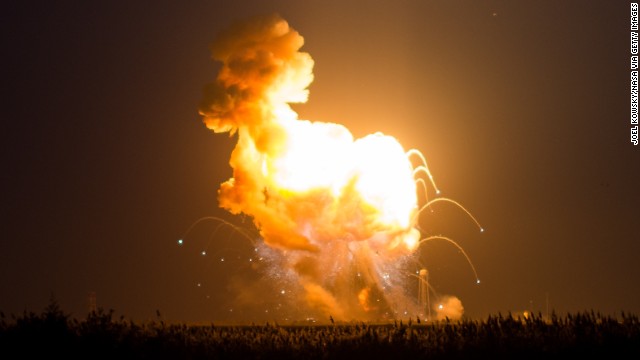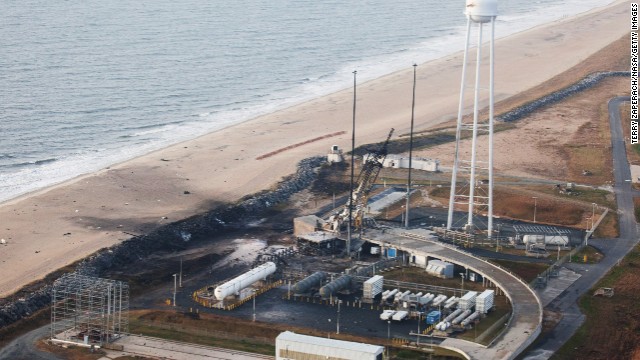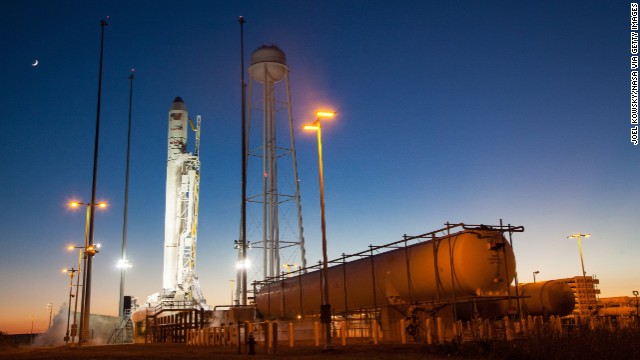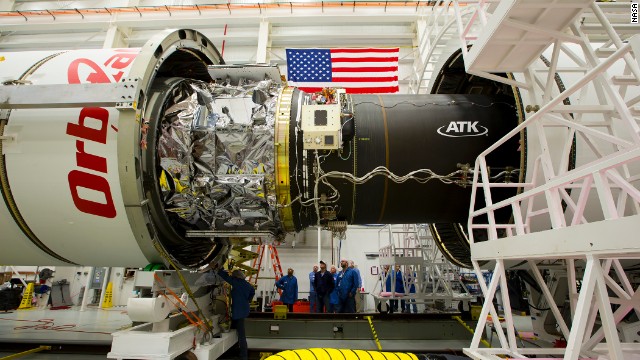 On what was to be a resupply mission to the International Space Station, an unmanned NASA-contracted rocket exploded seconds after launch Tuesday, October 28, on the coast of Virginia. The launchpad was damaged, but no one was injured.
On what was to be a resupply mission to the International Space Station, an unmanned NASA-contracted rocket exploded seconds after launch Tuesday, October 28, on the coast of Virginia. The launchpad was damaged, but no one was injured.  People who came to Wallops Island, Virginia, to watch the launch walk away after the unmanned rocket, owned by Orbital Sciences Corp., exploded.
People who came to Wallops Island, Virginia, to watch the launch walk away after the unmanned rocket, owned by Orbital Sciences Corp., exploded.  The rocket and spacecraft -- which together cost more than $200 million, according to Frank Culbertson, the general manager of Orbital's Advanced Programs Group -- are gone.
The rocket and spacecraft -- which together cost more than $200 million, according to Frank Culbertson, the general manager of Orbital's Advanced Programs Group -- are gone.  The rocket had been set to go up Monday, only to be scrubbed "because of a boat downrange in the trajectory Antares would have flown had it lifted off," according to NASA. Coast Guard spokesman David Weydert said the boat that triggered the postponement was 40 miles offshore. Tuesday, by contrast, seemed perfect. Just before liftoff, NASA reported "100% favorable" weather and "no technical concerns with the rocket or spacecraft being worked."
The rocket had been set to go up Monday, only to be scrubbed "because of a boat downrange in the trajectory Antares would have flown had it lifted off," according to NASA. Coast Guard spokesman David Weydert said the boat that triggered the postponement was 40 miles offshore. Tuesday, by contrast, seemed perfect. Just before liftoff, NASA reported "100% favorable" weather and "no technical concerns with the rocket or spacecraft being worked."  An aerial view of the Wallops Island facility is seen October 29 after the failed launch.
An aerial view of the Wallops Island facility is seen October 29 after the failed launch.  The Antares rocket, with the Cygnus spacecraft on board, is seen on Launch Pad-0A after the launch attempt was scrubbed on October 27.
The Antares rocket, with the Cygnus spacecraft on board, is seen on Launch Pad-0A after the launch attempt was scrubbed on October 27.  The Orb-3 mission's payload fairing (essentially the casing around the spacecraft) was installed on the Antares on October 23.
The Orb-3 mission's payload fairing (essentially the casing around the spacecraft) was installed on the Antares on October 23.  The payload fairing goes onto the spacecraft. Orbital will lead the investigation of the accident, along with the FAA, with NASA assisting. Among other things, they'll try to collect and examine any debris that can be recovered, review data from the spacecraft before its destruction and look at videos around the launch time.
The payload fairing goes onto the spacecraft. Orbital will lead the investigation of the accident, along with the FAA, with NASA assisting. Among other things, they'll try to collect and examine any debris that can be recovered, review data from the spacecraft before its destruction and look at videos around the launch time.
- Orbital Sciences Corp. confirms that the flight termination system was engaged
- Retired astronaut Mark Kelly says it was the right call
- The rocket was destroyed shortly after launch on the Virginia coast on Tuesday night
(CNN) -- After it became apparent there was a problem with the launch of the NASA-contracted Antares rocket, the company that operated the flight hit the destruct button, a spokesman said Thursday.
The flight termination system was engaged, confirmed Barron Beneski, vice president of corporate communications at Orbital Sciences Corp., in an email.
Mark Kelly, retired NASA astronaut and SpaceX advisory board member, said it was the right call.
 NASA investigates rocket explosion
NASA investigates rocket explosion "They commanded the destruct system to make sure it didn't wind up in a populated area when they knew it wasn't going to make it to orbit," he said.
The unmanned rocket was destroyed shortly after launch on the Virginia coast on Tuesday night.
Opinion: Rockets blow up; we move on
The crash caused a spectacular fire and scattered debris over a large area.
The cargo module was carrying 5,000 pounds of supplies and experiments meant for the International Space Station.
Will rocket's 'catastrophic failure' set back the private space industry?
CNN's Amanda Barnett contributed to this report.

via CNN.com - Top Stories http://ift.tt/10CU0Cd
No hay comentarios:
Publicar un comentario